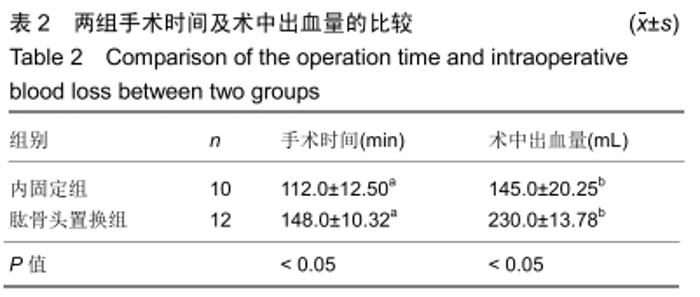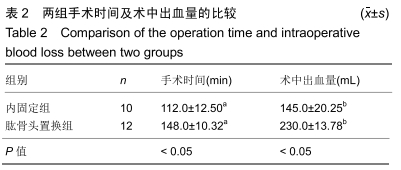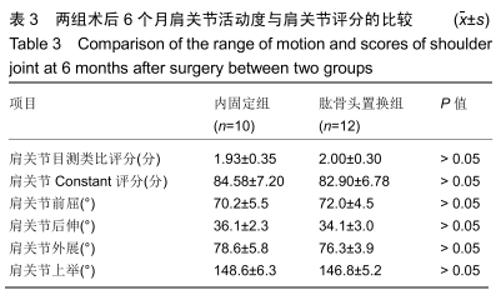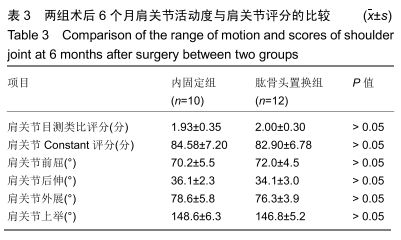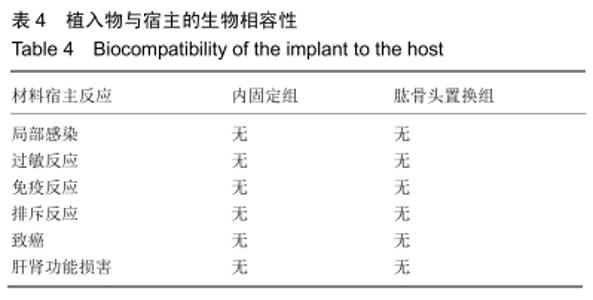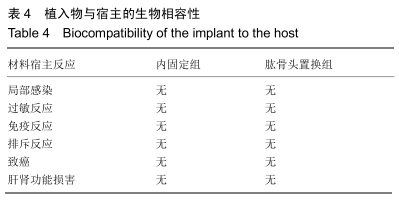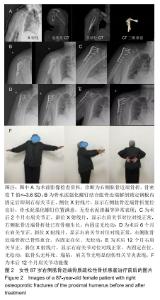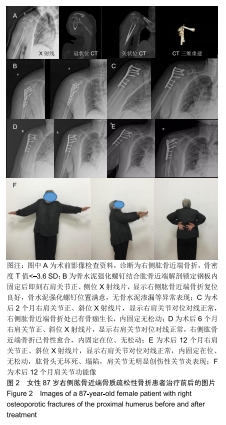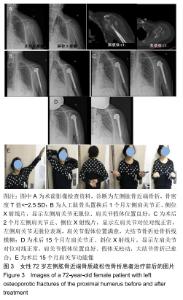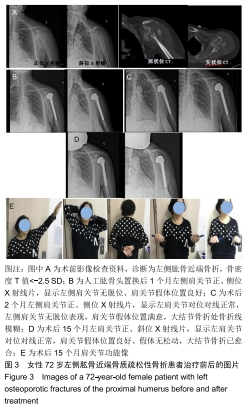Chinese Journal of Tissue Engineering Research ›› 2020, Vol. 24 ›› Issue (15): 2335-2341.doi: 10.3969/j.issn.2095-4344.2627
Previous Articles Next Articles
A novel cement-reinforced screw combined with locking plate
fixation versus humeral head
arthroplasty in the treatment of osteoporotic fractures of the proximal humerus
She Rongfeng, Zhang Yi, Wang Yuanzheng, Zhang Bin, Chen Peng, Huang Qixiang
- Guizhou Provincial People’s Hospital, Guiyang 550002, Guizhou Province, China
-
Received:2019-10-31Revised:2019-11-08Accepted:2019-11-29Online:2020-05-28Published:2020-03-22 -
Contact:Zhang Yi, Chief physician, Master’s supervisor, Guizhou Provincial People’s Hospital, Guiyang 550002, Guizhou Province, China -
About author:She Rongfeng, Master, Attending physician, Guizhou Provincial People’s Hospital, Guiyang 550002, Guizhou Province, China -
Supported by:the Science and Technology Program of Guizhou Province, No. [2019]4446 and [2019]1210; Youth Foundation of Guizhou Provincial People’s Hospital, No. GZSYQN[2015]04
CLC Number:
Cite this article
She Rongfeng, Zhang Yi, Wang Yuanzheng, Zhang Bin, Chen Peng, Huang Qixiang.
A novel cement-reinforced screw combined with locking plate
fixation versus humeral head
arthroplasty in the treatment of osteoporotic fractures of the proximal humerus
share this article
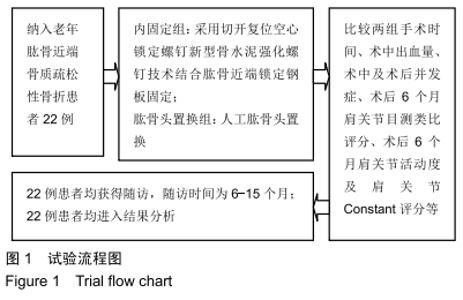
2.1 参与者数量分析 22例患者获得术后6-15个月的随访,平均随访时间(9.0±1.6)个月,均进入结果分析。 2.2 两组基线资料比较 内固定组10例患者中,男4例,女6例;年龄68-87岁,平均(75.0±1.2)岁;骨折按Neer分型,两部分骨折1例,三部分骨折6例,四部分骨折3例;受伤因数均为摔伤所致;合并有肋骨骨折2例、桡骨远端骨折1例、眼眶骨折1例,5例患有高血压病和糖尿病,3例患有冠心病,2例患有慢性支气管炎。肱骨头置换组12例患者中,男4例,女8例;年龄70-88岁,平均(76.0±1.6)岁;骨折按Neer分型,三部分骨折5例,四部分骨折7例;2例为车祸伤,10例为摔伤;合并有肋骨骨折1例、耻骨支骨折1例,6例患有高血压和糖尿病。两组均为闭合性骨折,排除病理性骨折。两组间性别、年龄、骨折分型比较差异无显著性意义(P > 0.05),具有可比性。 2.3 试验流程图 见图1。 "
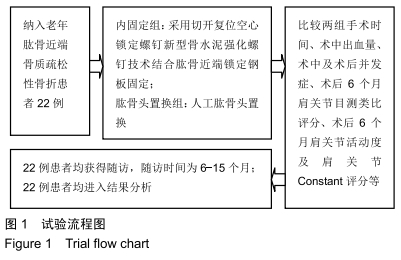
| [1] JABRAN A, PEACH C, REN L. Biomechanical analysis of plate systems for proximal humerus fractures: a systematic literature review.Biomed Eng Online.2018;17(1):47-54. [2] 江红卫,曹烈虎,宋绍军,等.纳米人工骨与同种异体骨植骨治疗肱骨近端Ⅲ、Ⅳ型骨折的临床疗效对比[J].上海医学,2012, 35(11):954-956. [3] PLATH JE, KERSCHBAUM C, SEEBAUER T, et al. Locking nail versus locking plate for proximal humeral fracture fixation in an elderly population: a prospective randomised controlled trial.BMC Musculoskelet Disord.2019;20(1):20. [4] FATTORETTO D, BORGO A, IACOBELLIS C. The treatment of complex proximal humeral fractures: analysis of the results of 55 cases treated with PHILOS plate. Musculoskelet Surg. 2016;100(2):1-6. [5] CHEN H, YIN P, WANG S, et al. The Augment of the Stability in Locking Compression Plate with Intramedullary Fibular Allograft for Proximal Humerus Fractures in Elderly People. Biomed Res Int.2018;2018:3130625. [6] KHIRA YM, SALAMA AM. Treatment of Locked Posterior Shoulder Dislocation With Bone Defect.Orthopedics.2017; 40(3):e501-e505. [7] UNGER S, ERHART S, KRALINGER F, et al. The effect of in situ augmentation on implant anchorage in proximal humeral head fractures.Injury.2012;43(10):1759-1763. [8] 邱贵兴,裴福兴,胡侦明,等.中国骨质疏松性骨折诊疗指南(全文) (骨质疏松性骨折诊断及治疗原则)[J].中华关节外科杂志(电子版),2015,9(6):795-798. [9] RUSSO R, D'AURIA D, CICCARELLI M, et al. Triangular block bridge method for surgical treatment of complex proximal humeral fractures: theoretical concept, surgical technique and clinical results.Injury.2017;48 Suppl 3: S12-S19. [10] GREY A, BOLLAND MJ. The effect of treatments for osteoporosis on mortality. Osteoporos Int.2013;24(1):1-6. [11] GE W, SUN Q, LI G, et al. Efficacy comparison of intramedullary nails, locking plates and conservative treatment for displaced proximal humeral fractures in the elderly.Clin Interv Aging.2017;12:2047-2054. [12] MELLSTRAND NAVARRO C,B ROLUND A, EKHOLM C, et al. Treatment of humerus fractures in the elderly: A systematic review covering effectiveness, safety, economic aspects and evolution of practice.PLoS One.2018;13(12):e0207815. [13] ANTONIOS T, BAKTI N, NZEAKO O, et al. Outcomes following fixation for proximal humeral fractures.J Clin Orthop Trauma.2019;10(3):468-473. [14] KIM TI, CHOI JH, KIM SH, et al. The Adequacy of Diagnosis and Treatment for Osteoporosis in Patients with Proximal Humeral Fractures.Clin Orthop Surg. 2016;8(3):274-279. [15] RATAJCZAK K, SZCZĘSNY G, MAŁDYK P, et al. Comminuted fractures of the proximal humerus - principles of the diagnosis, treatment and rehabilitation.Ortop Traumatol Rehabil. 2019;21(2):77-93. [16] CARBONE S, RAZZANO C, ALBINO P, et al. Immediate intensive mobilization compared with immediate conventional mobilization for the impacted osteoporotic conservatively treated proximal humeral fracture: a randomized controlled trial.Musculoskelet Surg.2017;101(Suppl 2):137-143. [17] KRUITHOF RN, FORMIJNE JONKERS HA, VAN DER VEN DJC, et al. Functional and quality of life outcome after non-operatively managed proximal humeral fractures.J Orthop Traumatol.2017;18(4):423-430. [18] 何和与,吴开弟,黄泽晓,等.中医手法复位治疗肱骨近端骨折 (Neer II、III 型)疗效分析[J].创伤外科杂志,2018,20(8):615-617. [19] STONE MA, NAMDARI S. Surgical Considerations in the Treatment of Osteoporotic Proximal Humerus Fractures. Orthop Clin North Am.2019;50(2):223-231. [20] SCHUMAIER A, GRAWE B. Proximal Humerus Fractures: Evaluation and Management in the Elderly Patient.Geriatr Orthop Surg Rehabil.2018;9:2151458517750516. [21] VIJAYVARGIYA M, PATHAK A, GAUR S. Outcome Analysis of Locking Plate Fixation in Proximal Humerus Fracture.J Clin Diagn Res.2016;10(8):RC01-05. [22] LAUX CJ, GRUBHOFER F, CML W, et al. Current concepts in locking plate fixation of proximal humerus fractures.J Orthop Surg Res.2017;12(1):137. [23] KLUG A, WINCHERINGER D, HARTH J, et al. Complications after surgical treatment of proximal humerus fractures in the elderly-an analysis of complication patterns and risk factors for reverse shoulder arthroplasty and angular-stable plating.J Shoulder Elbow Surg.2019.pii: S1058-2746(19)30126-0. [24] MAIER D, JAEGER M, IZADPANAH K, et al. Proximal humeral fracture treatment in adults.J Bone Joint Surg Am. 2014;96(3):251-261. [25] BOILEAU P, D'OLLONNE T, BESSIÈRE C, et al. Displaced humeral surgical neck fractures: classification and results of third-generation percutaneous intramedullary nailing.J Shoulder Elbow Surg.2019;28(2):276-287. [26] ALTINTAS B, BIBER R, BAIL HJ. Is it safe to assist proximal humeral nailing to residents? An analysis of 1134 cases.Injury. 2016;47 Suppl 7:S7-S9. [27] FROMBACH AA, BRETT K, LAPNER P. Humeral Head Replacement and Reverse Shoulder Arthroplasty for the Treatment of Proximal Humerus Fracturesm.Open Orthop J. 2017;11:1108-1114. [28] 姜春岩.关于人工肩关节置换的相关热点问题[J].中华创伤杂志, 2017,33(8):684-686. [29] BIAZZO A, CARDILE C, BRUNELLI L, et al. Early results for treatment of two- and three-part fractures of the proximal humerus using Contours PHP (proximal humeral plate).Acta Biomed.2017;88(1):65-73. [30] BOGNER R, ORTMAIER R, MORODER P, et al. Minimally Invasive Treatment of Displaced Proximal Humeral Fractures in Patients Older Than 70 Years Using the Humerusblock. Biomed Res Int.2016;2016:6451849. [31] KATHREIN S, KRALINGER F, BLAUTH M, et al. Biomechanical comparison of an angular stable plate with augmented and non-augmented screws in a newly developed shoulder test bench.Clin Biomech(Bristol,Avon).2013;28(3): 273-277. [32] RÖDERER G, SCOLA A, SCHMÖLZ W, et al. Biomechanical in vitro assessment of screw augmentation in locked plating of proximal humerus fractures.Injury.2013;44(10):1327-1332. |
| [1] | Xu Feng, Kang Hui, Wei Tanjun, Xi Jintao. Biomechanical analysis of different fixation methods of pedicle screws for thoracolumbar fracture [J]. Chinese Journal of Tissue Engineering Research, 2021, 25(9): 1313-1317. |
| [2] | Zhang Tongtong, Wang Zhonghua, Wen Jie, Song Yuxin, Liu Lin. Application of three-dimensional printing model in surgical resection and reconstruction of cervical tumor [J]. Chinese Journal of Tissue Engineering Research, 2021, 25(9): 1335-1339. |
| [3] | Du Xiupeng, Yang Zhaohui. Effect of degree of initial deformity of impacted femoral neck fractures under 65 years of age on femoral neck shortening [J]. Chinese Journal of Tissue Engineering Research, 2021, 25(9): 1410-1416. |
| [4] | Zhang Shangpu, Ju Xiaodong, Song Hengyi, Dong Zhi, Wang Chen, Sun Guodong. Arthroscopic suture bridge technique with suture anchor in the treatment of acromioclavicular dislocation [J]. Chinese Journal of Tissue Engineering Research, 2021, 25(9): 1417-1422. |
| [5] | Zhou Jihui, Li Xinzhi, Zhou You, Huang Wei, Chen Wenyao. Multiple problems in the selection of implants for patellar fracture [J]. Chinese Journal of Tissue Engineering Research, 2021, 25(9): 1440-1445. |
| [6] | Chen Junming, Yue Chen, He Peilin, Zhang Juntao, Sun Moyuan, Liu Youwen. Hip arthroplasty versus proximal femoral nail antirotation for intertrochanteric fractures in older adults: a meta-analysis [J]. Chinese Journal of Tissue Engineering Research, 2021, 25(9): 1452-1457. |
| [7] | Hu Kai, Qiao Xiaohong, Zhang Yonghong, Wang Dong, Qin Sihe. Treatment of displaced intra-articular calcaneal fractures with cannulated screws and plates: a meta-analysis of 15 randomized controlled trials [J]. Chinese Journal of Tissue Engineering Research, 2021, 25(9): 1465-1470. |
| [8] | Tang Hui, Yao Zhihao, Luo Daowen, Peng Shuanglin, Yang Shuanglin, Wang Lang, Xiao Jingang. High fat and high sugar diet combined with streptozotocin to establish a rat model of type 2 diabetic osteoporosis [J]. Chinese Journal of Tissue Engineering Research, 2021, 25(8): 1207-1211. |
| [9] | Li Zhongfeng, Chen Minghai, Fan Yinuo, Wei Qiushi, He Wei, Chen Zhenqiu. Mechanism of Yougui Yin for steroid-induced femoral head necrosis based on network pharmacology [J]. Chinese Journal of Tissue Engineering Research, 2021, 25(8): 1256-1263. |
| [10] | Xu Yulin, Shen Shi, Zhuo Naiqiang, Yang Huilin, Yang Chao, Li Yang, Zhao Heng, Zhao Lu. Biomechanical comparison of three different plate fixation methods for acetabular posterior column fractures in standing and sitting positions [J]. Chinese Journal of Tissue Engineering Research, 2021, 25(6): 826-830. |
| [11] | Hou Guangyuan, Zhang Jixue, Zhang Zhijun, Meng Xianghui, Duan Wen, Gao Weilu. Bone cement pedicle screw fixation and fusion in the treatment of degenerative spinal disease with osteoporosis: one-year follow-up [J]. Chinese Journal of Tissue Engineering Research, 2021, 25(6): 878-883. |
| [12] | He Li, Tian Wei, Xu Song, Zhao Xiaoyu, Miao Jun, Jia Jian. Factors influencing the efficacy of lumbopelvic internal fixation in the treatment of traumatic spinopelvic dissociation [J]. Chinese Journal of Tissue Engineering Research, 2021, 25(6): 884-889. |
| [13] | Yang Weiqiang, Ding Tong, Yang Weike, Jiang Zhengang. Combined variable stress plate internal fixation affects changes of bone histiocyte function and bone mineral density at the fractured end of goat femur [J]. Chinese Journal of Tissue Engineering Research, 2021, 25(6): 890-894. |
| [14] | Zhang Lei, Ma Li, Fu Shijie, Zhou Xin, Yu Lin, Guo Xiaoguang. Arthroscopic treatment of greater tuberosity avulsion fractures with anterior shoulder dislocation using the double-row suture anchor technique [J]. Chinese Journal of Tissue Engineering Research, 2021, 25(6): 895-900. |
| [15] | Yuan Xinping, Shao Yanbo, Wu Chao, Wang Jianling, Tong Liangcheng, Li Ying. Accuracy of target bone segments in personalized differential modeling and simulation of CT scanning parameters at fracture end [J]. Chinese Journal of Tissue Engineering Research, 2021, 25(6): 912-916. |
| Viewed | ||||||
|
Full text |
|
|||||
|
Abstract |
|
|||||
